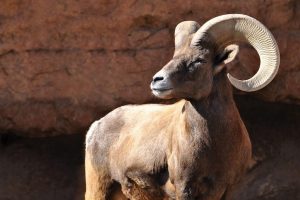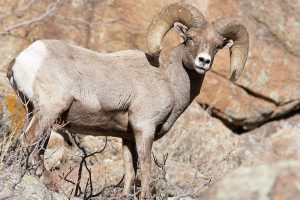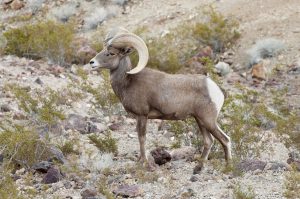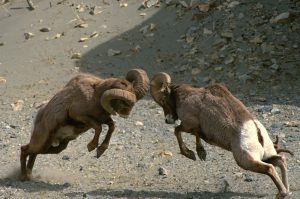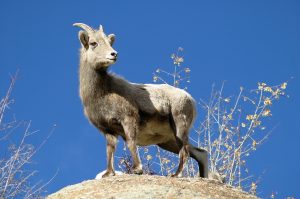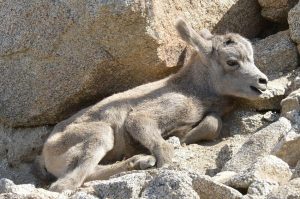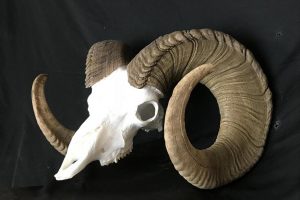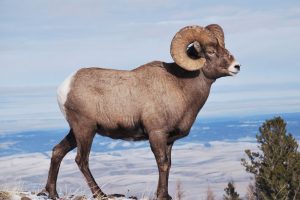Bighorn Sheep
The bighorn sheep, covered with wools, is known for its signature horns. The sturdy and strong horns are curled and twisted.
Scientific Classification
| Kingdom | Animalia |
| Phylum | Chordata |
| Class | Mammalia |
| Order | Artiodactyla |
| Family | Bovidae |
| Subfamily | Caprinae |
| Genus | Ovis |
| Scientific Name | Ovis canadensis |
Quick Information
| Description | Size: Males or rams are 35-41 in (89-104 cm) vertically and 63–73 in (160-185 cm) horizontally while females or ewes are 30-35 in (76-89 cm) height and 50-62 in (127-157 cm) in length Weight: Males are 128–315 lb (58-142 kg) and females are 75-201 lb (34-91 kg) Color: Gray or brown body, legs have white linings and rumps |
| Distribution & Subspecies | 1. O. c. Canadensis or Rocky Mountain bighorn sheep – Canada and U.S Rocky Mountains along with Northwestern United States 2. O. c. nelson or desert bighorn sheep – Northwestern Mexico and the Southwestern United States 3. O. c. sierra or Sierra Nevada bighorn sheep – Sierra Nevada of California |
| Habitat | Cool mountainous regions, deserts, alpine meadows, rocky cliffs, grassy slopes of mountains |
| Lifespan | Males live for 12-14 years while females live for 10-14 years |
| Diet | Sedges and grasses during the summer, rabbitbrush, willow for the winter and those living in deserts feed on cactus |
| Adaptations | 1. The big size of horn cores, frontal sinuses, and corneal along with internal bony structures help male bighorns withstand any clashes with horns and protect the brain 2. Their eyesight is excellent enough to help them jump and have a good foothold of the mountainous regions 3. They shed their coats to get used to the summery environment |
| Predators | Bobcats, golden eagles, lynxes, and coyotes, cougars, wolves and bears. |
| IUCN Conservation Status | Least Concern |
Behavior
- Adult males or bighorn sheep stay in small groups of 2-5 without any female or ewes, and juveniles. On the other hand, females and juveniles form groups having 5-15 members.
Mating and Reproduction
The period between November to December, being their mating season is known as ‘rut’ and prior to this phase, male bighorns compete with each other in order to allure females. The competition includes horn clashing. With a speed of around 20 mph and a possibility to last for an entire day, the fight gets the superior or winner male who mates finally. Post-mating, the gestation period lasts for 506 months and female bighorns give birth to 1 lamb.
Life-cycle
Newborn lambs are covered with light or pale, soft woolly coats and little horn buds. It takes 1 day to walk and subsequently climb, post birth. They spend the 1st year of their life with their mothers. Mostly, bighorns get matured around 2.5 years of age.
Interesting Facts
- Besides males, female bighorns can also fight for establishing superiority. Their horn fights are so intense that when two bighorns crash with each other, the sound is audible from miles away.
- The Rocky Mountain bighorn is the largest species of wild sheep of the entire North America.
References
- https://defenders.org/bighorn-sheep/basic-facts
- http://naturemappingfoundation.org/natmap/facts/bighorn_sheep_k6.html
- https://www.nps.gov/romo/learn/nature/bighorn_sheep.htm
- https://bighorn.org/about-bighorns/
Published on July 3rd 2019 by Sahana Kanjilal under Coniferous Forest Animals.
Article was last reviewed on 5th December 2024.



